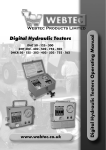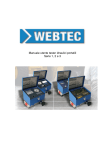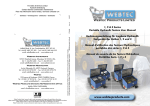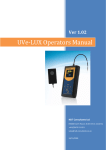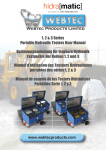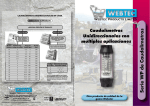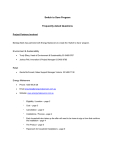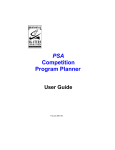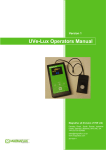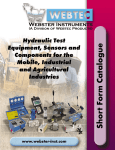Download DHM 403 - Oil Solutions
Transcript
For Sales & Service contact: Distributor 1290 E Waterford Avenue Milwaukee, WI 53235, USA. Tel: 414-769-6400 Fax: 414-769-6591 e-mail: [email protected] http://www.webster-inst.com Certificate No.8242 Webster Messtechnik Webtec S.a.r.l. An der Palmweide 55, 44227 Dortmund, Germany. Tel: 02 31 97 59 747 Fax: 02 31 97 59 710 e-mail: [email protected] http://www.webtec.co.uk 120 Avenue de Dunkerque 59400 CAMBRAI France Tel: +33 (0) 3 27 82 94 56 Fax: +33 (0) 3 27 82 94 55 e-mail: [email protected] http://www.webtec.fr Webtec Products Limited reserve the right to make improvements and changes to the specification without notice. www.webtec.co.uk Digital Hydraulic Multimeters Operating Manual Nuffield Road, St. Ives, Cambridgeshire, PE27 3LZ, UK Tel: +44(0)1480 397 400 Fax: +44(0)1480 466 555 e-mail: [email protected] http://www.webtec.co.uk DHM 403 / DHM 803 DHM-MA-ENG-1790.pdf Webster Instruments Designed and produced by Webtec Graphics. Webtec Products Limited Digital Hydraulic Multimeters FT9811 Issue A 11/06 Webtec Products Limited Distributor Oil Solutions Phone 0421 336 009 Fax 03 9012 4332 International Phone 61 421 336 009 Fax 61 3 9012 4332 [email protected] www.oilsolutions.com.au PO Box 653 Castlemaine Australia 3450 Notes Notes Digital Hydraulic Multimeter Operating Manual US Specifications Introduction DHM Series Digital Portable Hydraulic Multimeters have been designed for easy connection to a hydraulic circuit so that flow, pressure, peak pressure, temperature, power and volumetric efficiency can be readily checked. To facilitate easy operation all common engineering units can be selected. Testers can take full back pressure up to 420/480 bar (depending on model) and the built-in loading valve enables many of the operating conditions to be simulated. The tester can be connected anywhere in the hydraulic system to test pumps motors, valves and cylinders in both flow directions. Bi-Directional Flow Testing 1. The loading valve gives smooth control of pressure in both flow directions and is protected in both flow directions by two replaceable safety discs which are designed to rupture at approximately 7 bar (100 psi) over the maximum working pressure. When these discs rupture the oil by-passes the loading valve at low pressure and continues to flow freely through the hydraulic system. A range of pressure safety discs are available to protect both the tester and other components in the hydraulic system. 2. Although the bi-directional tester can be used in both flow directions, the preferred direction is indicated by IN and OUT on the tester block. When the tester block is used for reverse flow tests, slightly lower accuracies may be obtained depending on the oil viscosity, density and compressibility. 3. The tester should be connected to the hydraulic circuit by means of flexible hoses 1 - 2 metres long. The use of quick-disconnect couplings can save time. Make sure the hoses are long enough so that the tester can be used conveniently on the machine. The hoses and fittings at the inlet to the tester must be of adequate size for the flow being tested. Elbows, rotary couplings etc., at the inlet and outlet ports of the tester should be avoided to ensure accurate readings. 4. The use of the flexible hoses will help to isolate the test unit from vibration which often exists. 5. After installing the Tester it is important to ensure that all connections are tightened and the oil can flow freely throughout the hydraulic system BEFORE running the machine at full speed. Check that the circuit is correctly connected and any shut-off valves are opened, also quick disconnect couplers MUST be open. IMPORTANT start the pump momentarily to ensure there is no obstruction which could cause pressure build up. 6. Testers have an automatic electronic system which shuts the power off after approximately 20 minutes should you forget. To reactivate the tester, switch it “OFF” and then “ON” again Model Flow Range Temperature Range DHM403-S-6 DHM803-S-7 2.6 - 100 gpm 6.6 - 210 gpm 32 - 250 °F 32 - 250 °F Port Size Consult Sales office for US gpm models. Connections Adaptors Flow block connection by flexible hoses 3 - 6 feet (1 2 meters) Adaptor Fitting kits and flanges are available to suit the range of flow blocks. Consult the sales office. Measurement and Indication Flow Electronic count of an axial turbine designed to minimize pressure drop and the effects of changes in viscosity. The US version of the DHM displays flow in GPM Accuracy: 1% of indicated reading (IR) SAE O-ring ported version of the DHM displays temperature in °F. Accuracy: ± 2 °F Power Pressure and peak pressure Calculated from the flow and pressure, the hydraulic power is displayed in either HP or KW. The engineering units for power are linked to the pressure units and can be changed using the ‘pressure units’ button on the front panel. Accuracy: ± 2.5 HP (≤ 100 HP), ± 6.5 HP (> 100 HP) Built-in pressure transducer rated to 8700 psi. Has a typical response time of less than 1 ms to enable the accurate capture of peak pressures. The engineering units for pressure can be changed using the ‘pressure units’ button on the front panel. Standard units are PSI, BAR, MPA, KSC’. Accuracy: Pressure 0.5% FSD, Peak 1% FSD Volumetric efficiency Calculated as a ratio of the flow at high pressure to the flow under reference conditions. Volumetric Efficiency is expressed as a percentage. Accuracy: ± 1% point Temperature Thermistor built into the flow transducer to maximize contact with the oil flow and ensure fast response. The Construction Readout The DHM is microprocessor based and has three screens that can be toggled by the operator. Flow, pressure, peak pressure and temperature are displayed simultaneously on screens one and two. Power can be displayed in place of temperature at the touch of a button. The three screens show: all digital values, digital values with a bar graph, and P-Q test. volt battery enables more than 6 months normal testing time. The 9V (PP3, 64F22, 6AM6, A1604) battery is available worldwide. Turbine Block High tensile aluminium block houses a six blade turbine rotating on a stainless steel bearing and shaft. Built-in flow straighteners reduce flow turbulence and allows accurate flow measurement in both directions. The readout refreshes three times per second and uses low power circuitry to maximize battery life. The DHM has an auto power off feature that turns the unit off if unused for more than 20 minutes. The standard 9- General Loading Valve Dimensions (Inches) The integral loading valve allows smooth, progressive pressure loading in either flow direction with low handle effort. Safety discs relieve at approximately 300 psi over the max rated pressure internally by-passing the oil. Safety discs with pressure ranges up to 7000 psi are available. Consult the sales office for details. DHM403: 9.5 Wide, 8 Deep, 8 High Weight: Unpacked 14.3 lbs. Shipped 15.4 lbs. (Approx) DHM803: 10 Wide, 9 Deep, 9 High Weight: Unpacked 22 lbs. Shipped 24.2 lbs. (Approx) Operators Manual Full instructions are supplied with each tester. Seals How to Order Viton seals compatible with oil, water/oil emulsion are fitted as standard. EP seals for phosphate-ester are available to special order. 1 Pressure (bar) 0 - 6000 (0 - 8700 peak) 1-5/16 UN -12 #16 ORB 0 - 7000 (0 - 8700 peak) 1-7/8" UN-12 #24 ORB Specify the model number, e.g. DHM403-S-6, which is a 2.6 - 100 gpm unit with #16 SAE O-ring ports and US engineering units, suitable for pressures up to 6000 psi. 18 EU Specifications Trouble Shooting with the Hydraulic Tester Model Flow Range Temperature Range Pressure (bar) Port Size DHM403-B-6 DHM803-S-7 10 - 400 lpm 20 - 800 lpm 0 - 120 °C 0 - 120 °C 0 - 420 (0 - 600 peak) 0 - 480 (0 - 600 peak) 1” BSPF 1 7/8” - 12 UN PRELIMINARY: Check oil level in tank, pump drive, valve linkage for damaged parts, external oil leaks etc Consult Sales office for US gpm models. Connections Adaptors Flow block connection by flexible hoses 1 - 2 metres (3 - 6ft) long. Adaptor Fitting kits and flanges are available to suit the range of flow blocks. Consult the sales office. Measurement and Indication Problem Excessive pump noise fluctuating pressure Flow Measured by the electronic count of an axial turbine designed to minimise pressure drop and the effects of viscosity. The EU version of the DHM displays flow in lpm. Accuracy: 1% of indicated reading (IR) response. The EU version of the DHM displays temperature in °C. Accuracy: ± 1 °C Power Measured using a built-in pressure transducer rated to 600 bar. The transducer has a typical response time of <1 ms to enable the accurate capture of peak pressures. The engineering units for pressure can be changed using the ‘pressure units’ button on the front panel. Standard units are ‘BAR, PSI, MPA, KSC’. Accuracy: Pressure 0.5% FSD, Peak 1% FSD Pump cavitation caused by: a) Clogged suction filter b) Restricted suction line c) Air leak in pump suction line, fittings, shaft seals etc. d) Pump speed too high Suggested Test, See Paragraph: 3.0; 4.1 Decreasing performance as pressure increases on all circuits Internal leakage in: a) Pump b) Main Relief Valve 3.0; 4.1 4.2; 4.3 On one circuit c) Directional Control Valve d) Cylinder or Hydraulic Motor 4.2; 4.3; 4.4; 5.0 5.1; 5.2 Calculated as a ratio of the flow at high pressure to the flow under reference conditions. Volumetric Efficiency is expressed as a percentage. Accuracy: ± 1% point Fails to hold load Directional Control Valve Cross line Relief Valve Cylinder 4.2; 4.3; 4.4; 5.0 5.02 5.0; 5.2 standard 9-volt battery enables more than 6 months normal testing time. The 9V (PP3, 64F22, 6AM6, A1604) battery is available worldwide. The standard Webtec Hydraulic Testers are designed for use with mineral oil having reasonable lubrication properties. They are not suitable for use with water or fluids with a high water content. If a tester is used with water it should be flushed immediately after use with white or methylated spirit or similar and then flushed with mineral oil to minimise any internal corrosion. This may avoid an expensive repair. Damage to a tester from the use of a nonapproved fluid invalidates our normal warranty. Calculated from the flow and pressure, the hydraulic power is displayed in either HP or KW. The engineering units for power are linked to the pressure units and can be changed using the ‘pressure units’ button on the front panel. Accuracy: ± 3 kW (≤ 100 kW), ± 5 kW (> 100 kW) Pressure and peak pressure Low flow under no load Possible Cause Volumetric efficiency Temperature Sensed by a thermistor built into the flow transducer to maximise contact with the oil flow and ensure fast Construction Do not use with Water Readout The DHM is microprocessor based and has three screens that can be toggled by the operator. Flow, pressure, peak pressure and temperature are displayed simultaneously on screens one and two. Power can be displayed in place of temperature at the touch of a button. The three screens show: all digital values, digital values with a bar graph, and P-Q test. Turbine Block High tensile aluminium block houses a six blade turbine rotating on a stainless steel bearing and shaft. Built-in flow straighteners reduce flow turbulence and allows accurate flow measurement in both directions. The readout refreshes three times per second and uses low power circuitry to maximise battery life. The DHM has an auto power off feature that turns the unit off if unused for more than 20 minutes. The General Loading Valve Dimensions (Millimetres) The integral loading valve allows progressive pressure loading in either flow direction. Safety discs relieve at 20 bar over the max rated pressure to internally bypass the oil if the maximum pressure is exceeded. Safety discs with different pressure ranges up to 480 bar are available. Consult the sales office for details. DHM403: 240 Wide, 200 Deep, 200 High Weight: Unpacked 6.5 kg, Shipped 7 kg (Approx) Seals How to Order DHM803: 245 Wide, 225 Deep, 225 High Weight: Unpacked 10 kg, Shipped 11 kg (Approx) Operators Manual Full instructions are supplied with each tester. Viton seals compatible with oil, water/oil emulsion are fitted as standard. EP seals for phosphate-ester are available to special order. Specify the model number, e.g. DHM403-B-6, which is a 10 - 400 lpm unit with BSP ports and Metric engineering units, suitable for pressures up to 420 bar. 17 2 Getting Started Loading Valve DHM 800 lpm models If the loading valve becomes difficult to turn under pressure or will not close, remove the 4 bolts. Check for worn valve seat, damaged or leaking seals and contamination. Note: If the pressure does not increase progressively when the loading valve is operated, check if the safety discs have been ruptured. Assemble the loading valve into the flow block ensuring that the guide pin is located in the slot on the poppet valve (Fig. 7). Display Contrast Up ON/OFF switch Contrast Down Battery Cover Toggle screen ● ● ● ● ● ● ● ● ● Toggle: Temperature, Power, P-Q Clear peak Toggle pressure and power units Display - Large digital display. Automatically turns off if the unit is unused for more than 20 minutes. Contrast UP - Press & hold to make the screen text darker and easier to read in different light conditions. Contrast DOWN - Press & hold to make the screen text lighter. ON/OFF switch - Turn power to the unit ON or OFF with this switch. Toggle screen - This button toggles through the three display screens. Toggle: Temperature, Power, P-Q - Pressing this button will change the bottom line of the display from temperature to power. This button is also used when setting-up for efficiency on screen 3. Clear peak - Press to clear the peak pressure value Toggle pressure and power units - Toggles through a selection of engineering units for pressure and the corresponding power units. Battery cover - Remove this to replace the battery. Fig 7 Safety Discs DHM 800 lpm models The loading valve is fitted with two safety discs which are designed to rupture internally at approximately 100psi (7 bar) over the maximum pressure. When the discs fail, the loading valve becomes inoperative and the oil flows freely downstream. To replace the safety discs remove the loading valve assembly from the flow block. Unscrew the safety disc holder from the valve by carefully gripping the valve on the 35 mm diameter. Remove the disc spacer and the ruptured discs from the valve and disc holder. Carefully preform the two discs by pressing them by hand between the disc holder and spacer then place one new disc inside the valve and replace the spacer. Place a second disc on top of the space and screw in the disc holder (Fig. 8). Tighten the holder to 40lb. ft. (54 Nm) Grip on this Diameter Bi-Directional Loading Valve The reverse flow valve gives positive shut-off and pressure control in both directions of flow. The loading valve has two easily replaceable safety discs located in the valve assembly which internally protect the tester and machine in both flow directions. Disc holder Disc Spacer Disc Fig 8 3 16 Loading Valve DHM 400 lpm models If the loading valve becomes difficult to turn under pressure or will not close, remove the 4 socket screws. Check for worn valve seat, damaged or leaking seals and contamination. Note: If the pressure does not increase progressively when the loading valve is operated, check if the safety discs have been ruptured. Assemble the loading valve into the flow block ensuring that the guide pin is located in the slot on the poppet valve (Fig. 5). Screen 1 (Digital) ‘O’ Ring This screen displays the measurement type, value and engineering units in digital format. Anti-Rotation pin Screen 2 (Analogue) Fig. 5 Safety Discs DHM 400 lpm models The loading valve is fitted with two safety discs which are designed to rupture internally at approximately 7 bar (100psi) over the maximum pressure. When the discs fail, the loading valve becomes inoperative and the oil flows freely downstream. To replace the safety discs remove the loading valve assembly from the flow block. Unscrew the safety disc holder from the valve by carefully gripping the valve on the 30 mm diameter. Remove the disc spacer and the ruptured discs from the valve and disc holder. Carefully preform the two discs by pressing them by hand between the disc holder and spacer then place one new disc inside the valve and replace the spacer. Place a second disc on top of the space and screw in the disc holder (Fig. 6). Tighten the holder to 40lb. ft. (54 Nm) This screen displays the measurements in the same order as in SCREEN 1, but this time displays the value, engineering units and a bar graph which corresponds to the value indicated. The bar graph is scaled from zero to the maximum calibrated value for the tester (see below). Bar graph scaling: EU DHM403 DHM803 Flow Pressure Peak Temperature Power LPM BAR BAR °C kW 0 0 0 0 0 - 400 600 600 120 400 0 0 0 0 0 - 800 600 600 120 800 US DHM403 DHM803 GPM PSI PSI °F HP 0 0 0 32 0 - 100 08700 0 8700 0 250 32 536 0- 210 8700 8700 250 1072 Screen 3 (P - Q) Grip on this Diameter Disc holder Disc Spacer Disc Fig 6 15 This screen is used for testing pump efficiency. The screen initially displays flow and pressure on the top two lines as in SCREEN 2 and power on the bottom two lines. Once the efficiency reference point has been entered, then the third line displays the current efficiency and the bottom line shows the reference point, the top two lines will continue to display the current flow and pressure. 4 1-7/8” UN 7.7 kg Weight: 200 mm 167 mm on screen1 will change the bottom line of the display from temperature to power. 200 mm 5 DHM 403. 803 1/4” Pressure Port 133.4 mm 44.5 mm 1/4” NPT Pressure Port 14 10 kg Weight: 1-7/8”UN 245 mm now will allow you to change the engineering units for pressure. Keep pressing this button until the desired units are displayed. If power is being displayed, then its engineering units will change to suit the selected pressure units. 133 mm Pressing 44.5 mm again now, will change the bottom line of the display back to temperature. 201 mm Pressing Inlet/Outlet Ports See Specification 54 mm 226 mm If the pressure in the system is now increased and then decreased, the second line on the display will show the current pressure and the third line will show the peak pressure reached so far. Models: DHM 803 Pressing 270 mm Now that the tester is turned on, you may use the contrast adjustment buttons to set the contrast of the screen to suit the ambient lighting conditions. Once adjusted, the setting will be remembered for next time the tester is switched on. 192 mm Turn the tester on by flipping the rocker switch to the ‘ON’ position. The display will return to the last screen viewed, indicating the current conditions. The engineering units will be as selected when the tester was last used. If the screen starts flashing, then the battery should be replaced as soon as possible. Models: DHM 403 DHM Operation 5.3 Alternative Cylinder and Motor Test 5.31 Both motors and cylinders may also be tested as shown in drawing B.2. Disconnect the two lines from the motor and connect the tester into these lines. Fully open the loading valve, start the pump and bias the directional valve to allow flow to the inlet port of the tester. Slowly close the loading valve by turning clockwise and note the flow and pressure. If the flow is below the manufacturer’s data or lower than the pump flow test (3.0) investigate the control valve function. See Test (5.0). If the flow is correct and the speed is slow this indicates a defective motor or cylinder. Operate the directional valve to reverse the flow through the tester and record the flow throughout the pressure range. Press if you wish to see the readings displayed as values, engineering units and a bar graph, this is screen2. Pressing will once again allow you to change the engineering units for pressure. Pressing will toggle the bottom line of the display between temperature and power. Pressing at any time when on screen1 or 2 will clear the peak pressure. Pressing now will open screen3 used to test pump efficiency. When first accessing this screen, power will be displayed on the bottom line, until you have set your efficiency reference point. Cylinder Motor Relief Valve Directional Valve Test Hose Relief Valve Pump Drawing B2 13 6 To set the reference point for efficiency testing on screen3, you must first reduce the system pressure as much as you can and set your pump to the speed you wish to test at. Press and the current conditions will be stored as the reference (with the assumption that 100% efficiency is achieved at this point). The flow and pressure values for the reference point will be indicated on the bottom line of the display and the third line of the display will now show the calculated efficiency. The reference point will be lost if you press the toggle screen button. As you now load the system by increasing the pressure, any reduction in flow rate will reduce the efficiency value displayed on line 3 and will automatically update. 5.0 Directional Control Valve ‘In-Line’ Test (See drawing B.1) 5.01 To check the relief valve pressure setting where relief valves are integral with control valve, install flow meter in the cylinder line as shown in drawing B1,ensuring that loading valve is open (turn anti-clockwise). Start pump and operate the lever on the valve in which the tester is situated to raise load. Slowly close the loading valve (turn clockwise), reading pressure and flow, continue until loading valve is fully closed, pressure reading obtained is then relief valve pressure. Compare with manufacturer’s recommendations. Adjust relief valve if necessary. Using bi directional flow testers, the cylinder and valve may be tested in the opposite direction by operating the lever to retract the cylinder. 5.02 Control Valve Leakage With flow meter installed as in 5.01, repeat test and compare flow readings obtained for comparable pump test 3.3. Differences in flow readings indicate leakage within control valve. Repeat test for all power ports to fully determine valve condition. Replace control valve block or valve segment where necessary. 5.1 Cylinder Test (See Drawing B.1) 5.11 If the cylinder is slow in operation or cylinder ‘creeps’ under load the following test should be carried out to check the cylinder seals. Install the flow meter ‘in-line’ as shown in Drawing B.1. Actuate cylinder to raise and lower the load. Note flow and pressure readings, also note the time taken by the cylinder to reach full stroke. Compare all readings with manufacturer’s recommended figures. If flow is correct but time to extend cylinder is greater than expected leakage across the cylinder seals is indicated. If flow is lower than expected, investigate control valve function. See Test 5.0. 5.2 Motor Test 5.21 Motor performance is checked by measuring the flow and comparing it to the equivalent motor speed. Install the tester in the line upstream of the motor as indicated in the drawing B.1. Fully open the loading valve and operate the directional control valve ensuring the motor rotates in the correct direction. Allow motor to run under normal load. Note flow and pressure readings. If flow is below manufacturer’s data sheet or lower than pump test (3.0) investigate control valve function. See Test (5.0). Note: The motor may only be tested in reverse if it has an external drain. Do not pressurise the outlet port of the motor without first checking the allowable back pressure with the manufacturer. Motor Leakage 5.22 Measure hydraulic motor r.p.m. with a tachometer when motor is working at normal pressure. If the motor speed is low and the inlet flow in 5.21 is found to be correct, internal leakage in the motor is indicated. Check the motor leakage by installing the tester in the motor case drain. Note: most motors not fitted with high pressure shaft seals have a maximum case drain pressure of 1 bar (15 psi) 5.23 When the motor does not have an external drain or the motor cannot be back pressure loaded connect the tester in the other line and repeat the test 5.21 and 5.22 for the other motor direction. 7 12 It is not unusual for a relief valve to start cracking open below the maximum pressure setting causing considerable leakage and loss of machine performance. The cracking pressure can be checked by increasing the pressure slowly and noting the pressure at which the flow starts falling rapidly to zero. The maximum relief valve setting is when the flow is at zero. 4.3 Control Valve. Cylinder ‘TEE’ Test 4.31 Put control valve in power position. (On multiple spool valves, only one spool should be in a power position at any one time). The cylinder should be extended to the end of the stroke. 4.32 Close tester loading valve slowly while recording pressures and flow rate. 4.33 Repeat 4.32 for power position, for all spools of all control valves. 4.331 If all components are in good operating condition, pressure and flow measurements should be the same as in the pump test paragraph 3.0. 4.332 If the decrease in the flow of any control valve position is noted, leakage is indicated in this control valve or cylinder. See paragraph 4.4 for test routine to determine which is at fault. 4.333 If the decrease in flow is the same for the control valve(s) in all positions, it indicates the relief valve is at fault. (Note: This can also indicate some other leak is present in the control valve such as defective casting - but always check the relief valve FIRST) 4.4 Additional test to locate fault in control valve or cylinder (see paragraph 4.332). Disconnect line to cylinder and plug valve port. 4.41 Place control valve handle in position where greatest decrease of flow was noted. 4.42 Close tester loading valve and record both pressure and flow. 4.43 If the SAME decrease in flow is noted as in test per paragraph 4.332 then the control valve is at fault. HOWEVER, if the flow readings are now higher and comparable to the other control valves, then a faulty cylinder is indicated. Instructions for different test methods 0.0 The Tester is designed to measure flow, pressure, peak pressure, temperature, power and volumetric efficiency. It can take full system pressure up to 480 bar (420 bar on 400 lpm model) and measure flow in both directions for motor and cylinder testing. 0.1 Make all tests at operating temperatures because as the oil temperature increases the oil becomes thinner and any internal leakage becomes greater. 0.2 There are two basic test ‘set-ups’ when using the DHM testers: A) The In Line test to check out pumps, entire systems and also monitoring operating conditions. B) The Tee Test to check out pumps, directional control valves and overall system condition. 0.3 A preliminary check of the hydraulic system’s oil supply, pump rotation, filters, oil lines, cylinder rods as well as looking for external leaks should be made prior to installing the hydraulic tester. 1.0 Installing the Test Unit 1.1 Connect the tester to the circuit, see page 17 & 18 for Port Sizes. The inlet and outlet ports are marked on the turbine block. Use hoses and fittings of sufficient diameter for the flow being tested. Avoid restrictions at inlet and outlet ports of the Tester. Also avoid sharp bends because at high pressure hoses will deflect and straighten under pressure. 1.2 Ensure the pressure loading valve is fully opened by turning the knob counter clockwise before testing. 1.3 When no flow is passing through the turbine or there is no pressure, their respective readings will be “-LO-”. 1.4 Continue tests as specified in the following examples. Motor Relief Valve Directional Valve Test Hose Relief Valve Pump Drawing B1 11 8 2.0 Standard Test Conditions 2.1 Position the Hydraulic Test Unit as described in paragraph 3, 4 or 5. 2.2 Open loading valve (rotate counter-clockwise). 2.3 Start pump momentarily to ensure that oil flows freely through the hydraulic system, then run pump at normal maximum speed. Do not change pump speed while using the loading valve. 2.4 Slowly close Test Unit Loading Valve to develop desired pressure. Run the machine until normal operating temperature is reached. 2.5 Open the Testing Loading Valve and proceed with required test procedure (see paragraph 3, 4 or 5). 2.6 Keep a record of flow readings at various operating pressures for comparison of test results. The machine Manufacturer’s service manual should be consulted. 3.4 Pump flow at rated pressure can now be checked against the pump manufacturer’s specifications. The decrease in flow from the minimum pressure to maximum pressure determines the pump condition. Typically a worn or damaged pump will lose 20 - 30 percent. A pump that delivers low flow at both minimum and maximum pressure indicates suction problems. Blocked suction filters and pump cavitation problems can also be checked by recording the pump flow at various engine speeds. 3.5 The tester can be used at several points in the circuit and the machine can be used under its normal working conditions to evaluate the performance of the circuit elements, such as pump, control valve, cylinder and hydraulic motor. Cylinder Test Hose Relief Valve Cylinder Overall System ‘Tee’ Test Directional Valve Pump DHM Tee Connection Drawing A2 Relief Valve Pump DHM Test Hose 4.0 Test B - ‘TEE’ Test (See Drawing A2) 4.1 A ‘Tee’ must be installed at one point between the pump and control valve then connected to the “IN” port of the Tester. The “OUT” port of the tester is connected back to the tank. Make sure the loading valve is open. Note: Typically an elbow may be changed to a ‘Tee’ in most hydraulic circuits and the ‘Tee’ can be capped with a steel cap when not used for testing. 4.12 Pump Test. Disconnect and plug connection to control valve and proceed as in paragraph 3.2; 3.3 and 3.4. Drawing A1 3.0 Test 1 - Pump In Line Test (See Test Diagram A1) 3.1 Install the Tester into the system between the pump outlet port and the inlet to the directional control valve. 3.2 Open Tester loading valve to read maximum pump flow at minimum pressure. 3.3 Close loading valve slowly to increase pressure and note reduction of flow as the pressure is increased to maximum pump pressure to determine pump condition. 9 4.2 Overall System and Relief Valve Test (See drawing A2) (For relief valve integral with directional control valves) 4.21 Connect control valve to ‘Tee’. Operate control valve to extend the cylinder to end of stroke. 4.22 Close the Tester loading valve while watching pressure and flow meter reading. Pressure will increase until relief valve opens at which point flow reading will return to zero. Note or record pressure at this point. Adjust the relief valve if the pressure is below the recommended setting. 10













